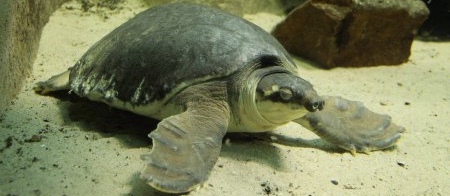ANIMAL: Fly River Turtle/Pig-Nosed Turtle Carettochelys insculpta Type of Animal: Turtle Habitat: Freshwater/brackish water: Streams, lagoons, rivers, estuaries, lakes, swamps, pools, river deltas, waterholes, billabongs, ponds, coastal areas, creeks, thermal springs, found in water 3-9 ft (up to 22 feet deep), nests on beaches/sandy riverbanks/shores (often forested but not always), prefers stable clear water w/ high pH/alkalinity, soft/sandy/gravel bottom & ribbonweed beds, females prefer sandy flat rock microhabitats, males prefer isolated log microhabitats, sometimes found in open sea. Location(s): S New Guinea & major river systems of NW Northern Territory in Australia Appearance: Distinct piglike nose w/ 2 wrinkly nostrils, flippered feet like sea turtles (only freshwater turtle w/ true flippers), fleshy snout, females bigger than males, leathery grey/olive carapace (upper shell), cream plastron (bottom shell), males have longer/narrower tails Food/Diet: Fruit (especially figs & bush apples), eel weed, shrimp, aquatic plants (especially water hyacinth, watercress, duckweed & waterweeds), worms, fish, leaves, insects, snails, crayfish, crabs, insect larvae, bats, flowers, algae, greens, seeds, carrion, vegetables Status in Wild: Endangered Conservation: Breeding from zoos, aquariums, & private breeders Lifestyle: Solitary Additional Info: Called: Male Female Young-Hatchling Group-Solitary Weight: Male-30 lbs Female-45-50 lbs Gestation: 2 months Life Span: 25 years in wild, 35 years in captivity Body Length: Male-1.5 ft Female-2.29 ft Tail Length: Male-5-6 in Female-3 in Main predators of adults are crocodilians. Monitors prey on eggs. Endangered due to pet trade, egg collection, harvesting for meat, water pollution, habitat loss/alteration, trampling of nest sites, water buffalo eating riverside vegetation, increased siltation of rivers, mining, mineral/oil exploration, & changes in vegetation/water flow due to agricultural activities. Sexually mature at 16 years old. Lay eggs in late dry season & eggs hatch at start of wet season. They grow rather slowly. Fun Fact(s): Snout acts as snorkel when swimming. Over 50% of females in given population have mating scars from male biting neck or male scratching female’s carapace w/ his claws Males never leave water & females only do so to nest. Only member of its genus (Carettochelys) & family (Carettochelyidae) in existence today.

